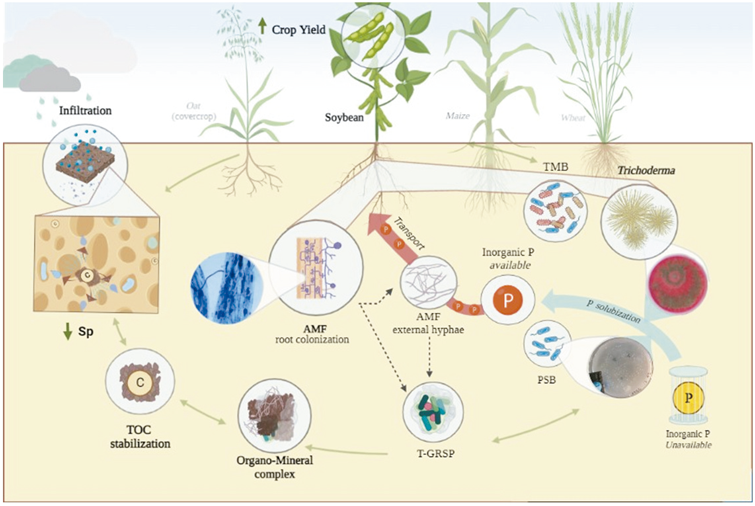Ecología Austral, 330–345, 2024
Abstract
Low crop diversification in highly productive areas has led to declines in total organic carbon (TOC) in soil, essential nutrients for plant’s growth and microbial diversity/activity. This could have an impact on the movement of water in the soil profile and, consequently, on the production of crops. To address these challenges there is growing support for crops intensification, which involves increasing the number/variety of crops throughout the year. The purpose of this study was to assess the influence of crop intensification on the initial infiltration of water in the upper layer of the soil profile and the activity/abundance of soil microorganisms involved in the turnover of TOC and phosphorus (P). Three crop regimes were assessed in a long-term experiment established in the southeast of the Argentinean Pampas: without intensification (Monocrop: soybean), intensified (Cover crop: CC [oat]/soybean) and Rotation (CC [oat]/soybean-corn-wheat). Soil in the Monocrop regime exhibited the highest sorptivity values and a lower TOC, suggesting a higher initial rate of water entry into the profile, which could break down soil aggregates. Under rotation, the highest infiltration rate was recorded, which would guarantee more water flow into the profile. Intensified soils showed the highest total glomalin content and root colonization with arbuscular mycorrhizal fungi (AMF), which are known to contribute to plant nutrient uptake and growth and soil aggregate stability. Trichoderma abundance and their P-solubilizing capacity were also higher under Rotation, which could favor AMF activity. Correlation analysis revealed a significant positive correlation between sorptivity and glomalin under Rotation. Our study suggests that soils from the Argentinean south-eastern Humid Pampas under crop intensification promote soil water storage and maintenance of soil structure in the upper layers compared to Monocrop, which could be atributed —at least in part— to a greater microbiological activity and TOC content.
Keywords: arbuscular mycorrhizal fungi, monocrop, cover crop, rotation, glomalin, water inflow
Resumen
La intensificación de cultivos influye en la infiltración de agua y la actividad microbiana en suelos agrícolas del sudeste de la Pampa argentina. La escasa diversificación de cultivos en zonas muy productivas ha disminuido la calidad del suelo, impactando en el movimiento de agua del perfil de suelo y, consecuentemente, en la producción de cultivos. Por ello, la intensificación de cultivos (aumento del número/variedad de cultivos a lo largo del año) es una estrategia a considerar. Nuestro objetivo fue evaluar si la intensificación de cultivos impacta en la infiltración inicial del agua en las capas superficiales del perfil de suelo y en la actividad/abundancia de microorganismos edáficos que participan en el recambio de carbono orgánico total (TOC) y de fósforo (P). En un experimento de larga duración establecido en el sudeste de la Pampa argentina se evaluaron tres regímenes: sin intensificación (monocultivo de soja), intensificados (cultivo de cobertura: CC [avena]/soja) y rotación (CC [avena]/soja-maíz-trigo). El suelo bajo monocultivo exhibió mayor sortividad y menor TOC que los suelos bajo CC y rotación, sugiriendo una mayor tasa inicial de entrada de agua en el perfil y una potencial ruptura de los agregados. El suelo bajo rotación presentó una tasa de infiltración más alta, lo que garantizaría un mayor ingreso de agua en el perfil. Los suelos bajo intensificación mostraron mayor contenido de glomalina total y colonización de raíces por hongos micorrícicos arbusculares (AMF), que favorecen la nutrición y el crecimiento vegetal y la estabilidad de agregados del suelo. La abundancia de Trichoderma y su capacidad solubilizadora de P fueron mayores en rotación, lo que habría favorecido la actividad de los AMF. Suelos bajo rotación presentaron una correlación positiva entre sortividad y glomalina. Nuestros resultados sugieren que la intensificación de cultivos favorecería el almacenaje de agua en el suelo, manteniendo la estructura del horizonte superficial, en comparación con suelos bajo monocultivo, probablemente por una mayor actividad microbiológica y contenido de TOC.
Palabras clave: hongos micorrícicos arbusculares, monocultivo, cultivo de cobertura, rotación, glomalina, flujo de agua
Figure 6. Proposed model of the possible contributions of beneficial microorganisms (AMF, Trichoderma, PSB and TMB), their activity (LH-AMF, T-GRSP, P solubilization) and organic compounds (TOC) modulating the initial stages of water infiltration (Sp) and fertility in the root-associated soil of the upper-horizon. Brightly colored plant: representation of the soybean crop. Plants in color with transparency: representation of crops that can be incorporated in crop intensification systems. AMF: Arbuscular mycorrhizal fungi. PSB: Phosphorus solubilizing bacteria. TMB: Total mesophilic bacteria. LH-AMF: AMF external hyphal length. T-GRSP: Total glomalin-related soil proteins. TOC: Organic carbon total. Sp: Sorptivity. Scheme created with BioRender.com. Photos: F. Covacevich and G. A. Fernández-Gnecco.
